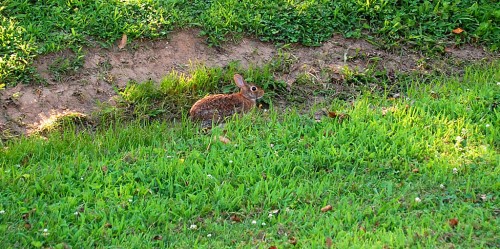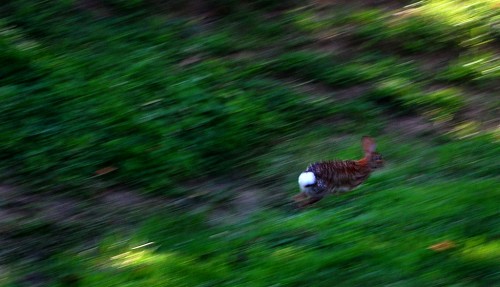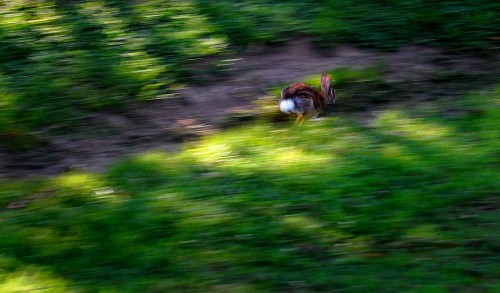 Many photographers think that faster shutter speeds are better. It’s true that a fast shutter speed will minimize camera shake on your end and subject movement on the far end. That’s usually a good thing. It can also be a formula for a dull photo. I was walking around Franklin School shooting an update now that construction of the new building is under way. (I’ll publish those photos in a day or so. I figure everybody is busy blowing things up this weekend, so I may hold off posting until there is someone around to see it.)
Many photographers think that faster shutter speeds are better. It’s true that a fast shutter speed will minimize camera shake on your end and subject movement on the far end. That’s usually a good thing. It can also be a formula for a dull photo. I was walking around Franklin School shooting an update now that construction of the new building is under way. (I’ll publish those photos in a day or so. I figure everybody is busy blowing things up this weekend, so I may hold off posting until there is someone around to see it.)
This cute little bunny rabbit was chowing down on the clover along the terrace in front of the school. I shot a quick frame and kept walking to go up the stairs to photograph the main entrance and flag pole. The bunny is reasonably sharp and relatively well exposed. It’s also not very interesting, unless, of course, you care more about bunnies than I do. (You might have a better idea what I’m talking about if you click on the image to make it larger.)
How to capture a feeling of speed
First off, I’m going to confess that this photo of the rabbit blasting out is an example of instinct and luck. I didn’t plan it. HAD I planned it, here are some things I would have done:
- I would have picked a relatively show shutter speed.
- I would have put the moving subject in the middle of the frame.
- I would have opened the shutter when the subject was slightly less than 90 degrees from me.
- I would have panned (followed) the subject at the same speed it was moving.
- I would have continued the pan until I heard the shutter close.
What does panning do?
What does that accomplish? It keeps the subject recognizably sharp, but makes the background a blur. We’re used to looking out the car window and watching the scenery go by so quickly that it’s a blur. That’s how we know that we’re moving and how fast. This isn’t a great shot, but it has some interesting things helping it out.
- The back ground light coming from behind the rabbit is mottled. That pattern of light and dark accentuates the feeling of blur and speed.
- The backlight coming through the rabbit’s ears makes them stand out and look pink.
- He’s caught in mid-hop, so the bulk of his body is stationary. You can clearly read “rabbit” from the ears and cottontail.
Why did I say it was instinct and luck? I had set the basic exposure, but left the camera on automatic. Because it was getting late in the day and I was in the shadows, the camera opted for a slow shutter speed serendipitously. When I saw the rabbit start to move, I followed the movement out of habit and practice.
I’m not a hunter, but I was a decent shot and was pretty good for an amateur the couple of times I tried shooting skeet. There’s not a whole lot of difference between shooting with a camera and with a gun. (Except that the rabbit gets to run away to eat clover another day.)
What a difference a millisecond makes
 The time stamp on the photo is exactly the same as the shot above. That means they were both shot less than a second apart. It’s less successful (in my opinion). You can see the rabbit is in a different point in his hop. His hind legs are rotating down, which causes a blur within the blur of his body. His front legs must be moving back, because his fur is also a blur in a different direction. He’s moved out of the nice backlighting, so his ears aren’t as nicely defined. His head has moved to an angle where he could almost pass for a cat were it not for the cottontail. He’s also quite a way off 90 degrees from the camera, so the blur doesn’t work quite as well.
The time stamp on the photo is exactly the same as the shot above. That means they were both shot less than a second apart. It’s less successful (in my opinion). You can see the rabbit is in a different point in his hop. His hind legs are rotating down, which causes a blur within the blur of his body. His front legs must be moving back, because his fur is also a blur in a different direction. He’s moved out of the nice backlighting, so his ears aren’t as nicely defined. His head has moved to an angle where he could almost pass for a cat were it not for the cottontail. He’s also quite a way off 90 degrees from the camera, so the blur doesn’t work quite as well.
This is a technique that you don’t use often, but it’s very effective when it works and it’s not hard to do with a little practice. In the old silver film days, it cost money to practice if you actually pushed the button and exposed the film, so we’d sit on the side of the road and practice following cars as the drove by. It’s critical that you do your pan in a smooth, level movement. With digital cameras, it doesn’t cost you anything to actually press the release. Do it.
I’ve never used it, but my strobe and camera have the ability to add another dimension to this technique. You select a slow shutter speed and start your pan. When the shutter is open and you’re following the subject, you get the nice movement blur behind subject. Just before the shutter closes, the strobe will go off, freezing the subject cold. You get the best of both worlds: the illusion of speed, PLUS a tack-sharp subject at the end.


Bunny #2 also has appropriately big eyes for the occasion. And its body hairs seem to be standing on end in a suitable alignment.
BTW, it’s your patriotic duty to do something slightly unsafe and illegal on the Fourth. It’s OK to stop short of sacrificing body parts or valuable property to the general conflagration.
Ken, a valuable tool that is included with all the pocket digitals is the zoom. The photographer can tighten up on the subject a little (zoom in) and possibly improve the shot.
I took a lot of pictures at race tracks over the years, especially Mid-America Raceway in Wentzville, and I found that my 200mm f4 telephoto lens was just about perfect for framing the subject but leaving enough background to get a good capture of the sense of speed.
I was at maximum zoom – 55mm – when I was shooting. When I switched to Human Zoom (stepping closer to the subject), the rabbit took off.
I had a whole stable of lenses when I shot film, everything from a fisheye to 500mm, with access to a 1000mm in the company pool locker. Unfortunately, they don’t fit the Nikon D40 I use.
I COULD move up to a body that would let me use the old lenses, but it would be much more expensive and, worse, be much heavier. That’s a factor when I want to take it on the bike.
I miss my 24mm wideangle lens and the 180mm telephoto, but I’ve learned to adapt to an 18-55 zoom.
Ken, even though there may be a bit of a blur, it’s still a good shot. Wish I could do as good!
Joe “45”
The cameras I had, and still have, are the Pentax K1000 and ME Super. When I decided on digital SLR, I landed on the Pentax ist DL so I could use all the lenses that I already had as well as the new ones I got with/bought for the new camera. The only quirk is that the old lenses become 1.5x their orignal focal length. My 200mm became a 300! The ist DL is a quite small DSLR but it has a large image sensor which yields great resolution.
It’s funny how Cape was a Pentax town. Nowell’s could get Nikon gear, but I don’t think Bill Nowell stocked it.
Frony was a Pentax user and I became one by default. I didn’t own Nikon equipment until I got to Ohio University and a fellow student who needed cash sold me a Nikon F body and three lenses for $150.
Up until then, I was prepared to argue that Pentax was superior to Nikon. One argument was that Pentax lenses screwed in, which, in theory, should have made their focus superior to Nikon’s quick release, which allegedly could loosen up.
In practice, I NEVER had an issue with the quick release and found it handy to be able to push the release with the side of my finger while I was swapping lenses. It was so much faster than having to use two hands to unscrew the lens and then put the new one on.
I don’t even remember who ended up buying my Pentax gear. I don’t know if I brought it back to Cape to have Nowell’s sell it for me of it I unloaded it in Ohio.
Thanks for the photography lesson. I have become a lazy photographer. The automatic feature on my camera is so easy. The fact that most of my subjects are either rooted to the earth or sitting still at grama’s request make it very effective. Glad I had a day off today to catch up on your blog.